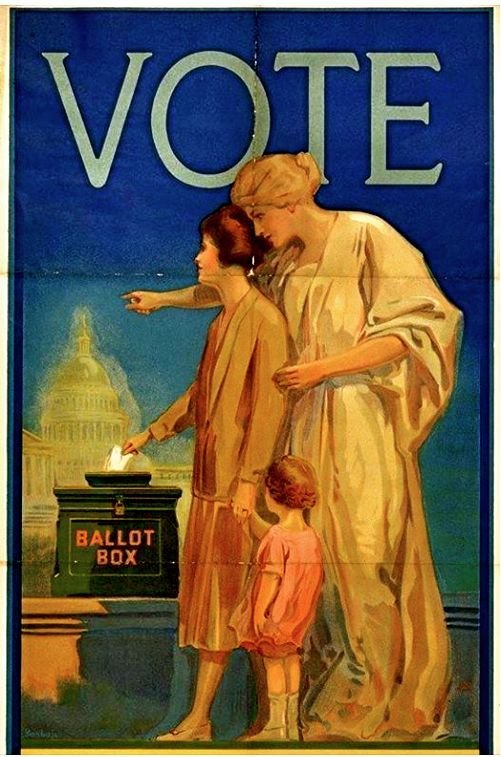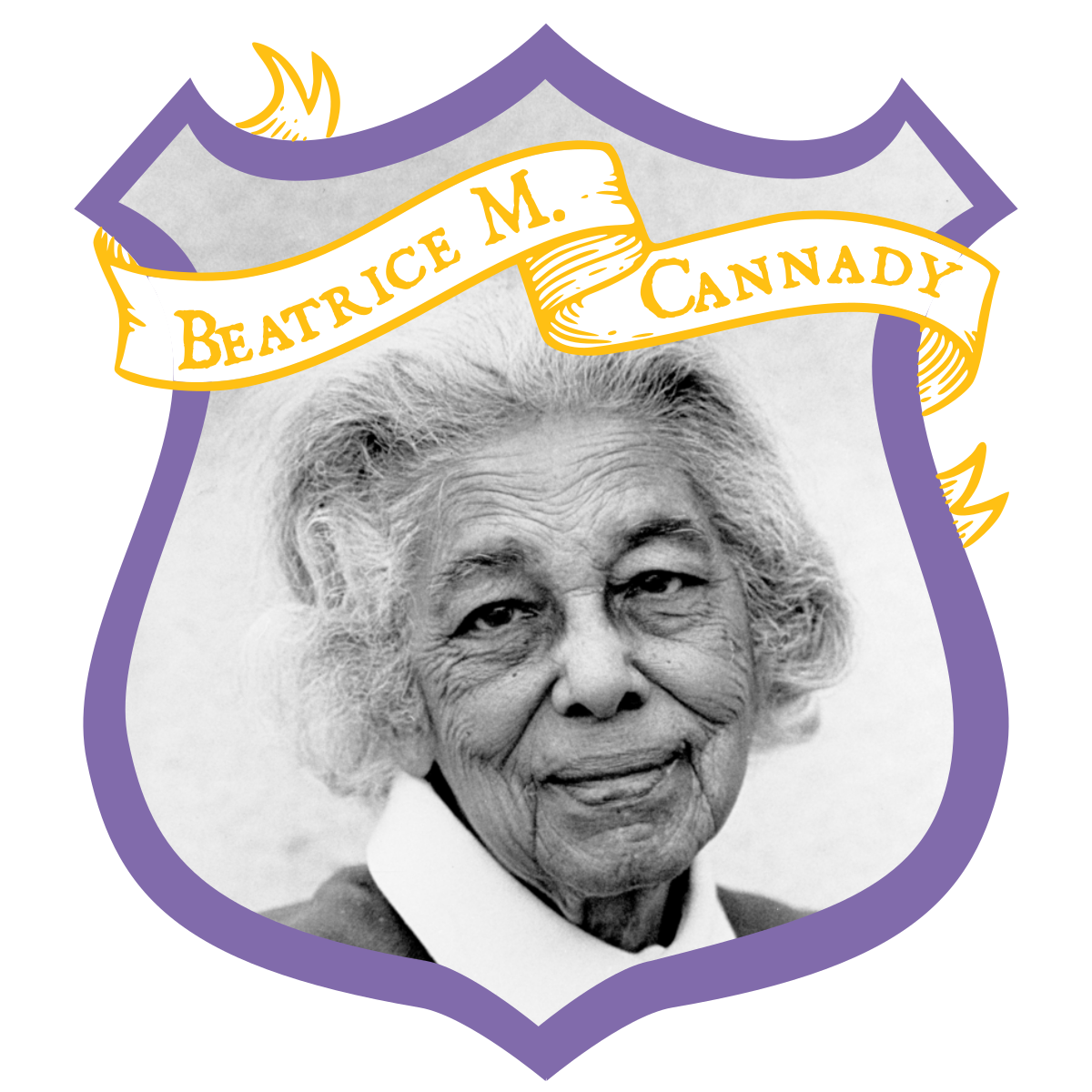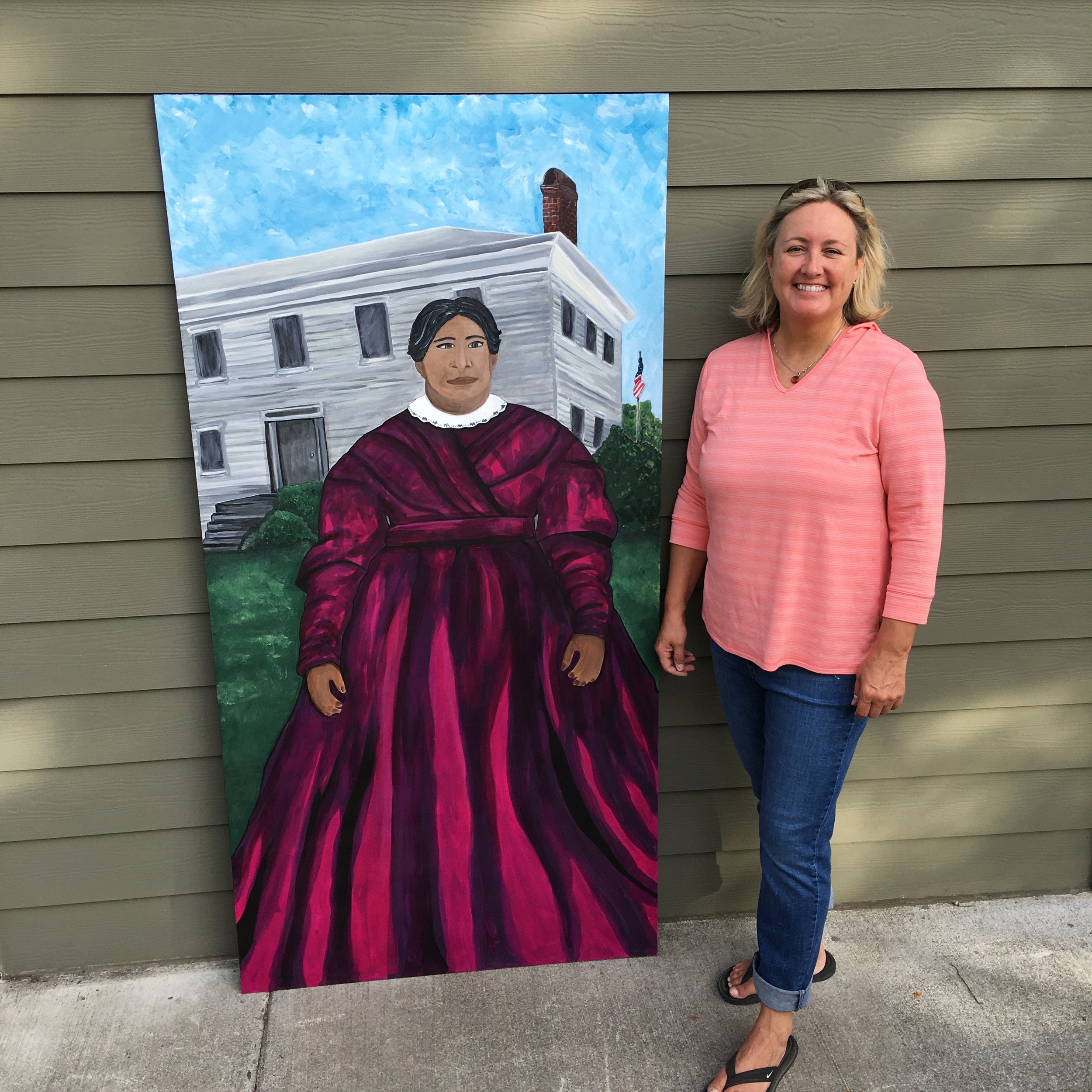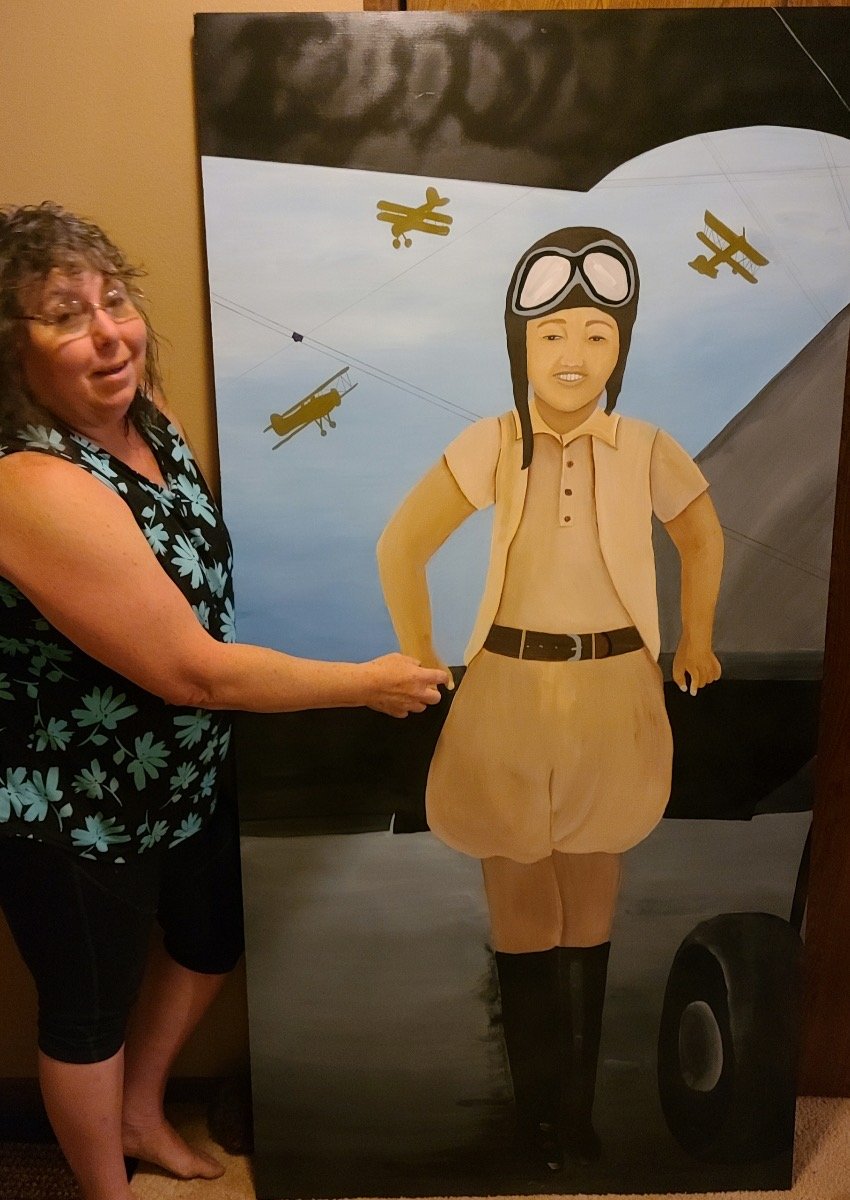About the Project
The year 2020 marked the 100th anniversary of the Nineteenth Amendment, which granted women the right to vote in the United States. Clackamas County Heritage Council partnered with the Three Rivers Artist Guild to create mobile figures that depict several significant women and movements in Oregon history. These unique art pieces were posted at various historical sites and local businesses around Oregon City and greater Clackamas County and have continued their tour well into 2022.
Fantastical Woman
The phrase, "She Flies With Her Own Wings," originated with Jessie Quinn Thorton (1810-1888), a Supreme Court Justice of the Provisional Government of Oregon. The words reflect the decision made at the third Champoeg Meeting on May 2, 1843 to form a provisional government independent of the United States and Great Britain. The motto appeared in Latin, "Alis Volat Propriis," on the Territorial Seal in 1854. Oregon readopted "She Flies With Her Own Wings," as the state motto in 1987. In wake of the 100th anniversary of the Nineteenth Amendment the phrase takes on an even deeper meaning that signifies both female independence and freedom. One that not only breaks through "the glass ceiling," but soars far above it.
The 42-year struggle to achieve voting rights for women in Oregon is a vital element of Oregon’s history and an important part of the movement for human rights and social justice across the globe. Oregon put the question of votes for women on the ballot six times in 1884, 1900, 1906, 1908, 1910, and 1912. This was more than any other state in the nation and eight years before the ratification of the Nineteenth Amendment to the U.S. Constitution in 1920. With the success of the 1912 vote, Oregon women became among the first in the United States able to pursue elected office and jury service.
VOTE poster by the League of Women Voters. Public Domain; 1920.
All Oregon women faced gendered barriers in their struggle to achieve voting rights and other elements of full citizenship. However, women of color, women in many immigrant communities, and members of the LGBTQ community confronted multiple challenges because of these added elements of discrimination. Native American women have worked to maintain their trial sovereignty and survival as they also claimed voting rights and other elements of citizenship in Oregon and the United States.
Nine African-American women posed, standing, full length, with Nannie Burroughs holding banner reading, "Banner State Woman's National Baptist Convention.” Library of Congress; between 1905 and 1915.
The U.S. Congress passed the Nineteenth Amendment guaranteeing all U.S. citizens the right to vote on June 4, 1919. Oregon suffragists joined together to lobby the Oregon legislature to ratify the amendment. Their efforts paid off when, on January 12, 1920, Oregon became the 25th state to achieve ratification. When Tennessee became the final state to ratify the amendment, votes for women activists celebrated throughout Oregon.
ABOUT THE ARTIST
Trieste Andrews paints from personal inspirational scenes and people as well as commissioned pieces. She works primarily with oil and acrylic. Her works include landscapes, animals and portraits. She serves as the president of the Three Rivers Artist Guild (TRAG) in Oregon City. TRAG is a non-profit organization of more than 125 members dedicated to support art in their communities.
Beatrice Morrow Cannady
Beatrice Morrow Cannady was an early and outspoken civil rights activist in Oregon. After moving to Portland from Texas in 1910, she met her first husband Edward Daniel Cannady who was co-founder and editor of The Advocate newspaper. In 1914, she helped found the Portland Chapter of the National Association for the Advancement of Colored People (NAACP).
Beatrice Morrow Cannady. Oregon Historical Society Research Library, OrHi 63845; 1912.
She was the first Black woman to graduate from Northwestern College of Law and helped to write Oregon’s first civil rights legislation. In 1925 she was part of the campaign to repeal the state’s “black laws” which outlawed Blacks from living in Oregon and denied people of color the right to vote. In 1929, Cannady became the chief editor of The Advocate newspaper and in 1932, she ran for congress for Oregon’s fifth district. Though she lost, her efforts were a great inspiration to other Black leaders.
Marie Equi
During the late nineteenth and early twentieth centuries, Dr. Marie Equi was a strong advocate for women’s suffrage, free speech and reproductive and labor rights. She spent her early life in Massachusetts as the daughter of two immigrant working-class parents who regularly struggled with anti-immigrant sentiments, dangerous working conditions, and a lack of health and childcare. Equi moved to Oregon at the age of twenty and settled with another woman on a homestead near The Dalles in 1892. Her fervor for equal treatment became obvious in 1893 when she horsewhipped a school superintendent after his refusal to pay her companion’s salary.
Marie Equi. Public domain; date unknown.
Equi moved to San Francisco for medical school, eventually receiving her degree from the University of Oregon in 1903 and becoming one of the few women physicians in Oregon. She set up her own practice in Portland where she primarily treated working-class women and children. Here, she distributed birth control and provided abortions. Unconventional for the period, Equi was openly gay and adopted a baby girl, Mary, whom she raised with her partner.
Equi’s most vehement years of activism were 1903 through 1913. She worked with Abigail Scott Duniway to secure voting rights for women. She advocated for an eight-hour workday and various other educational, labor, and prison reforms. By 1913 her efforts became more radical and she embraced anarchism. She fiercely opposed the U.S. entering World War I, believing that it was a capitalist effort to profit from death and destruction. In 1918 she was imprisoned for ten months in San Quentin Prison for her outspoken anti-war speeches. After her release she became less involved in activism and eventually left her medical practice in 1930 for health reasons. She spent her final years with her daughter in Portland until her death in 1952.
ABOUT THE ARTIST
Lucas Nickerson is a visual artist and story-teller based in Oregon City, Oregon. Through the use of animals, people, symbolism, and puns, he creates paintings that inspire unique interpretation of their meaning. Primarily, he paints animals, he does human figurative and portrait work as well.
“I have a lot of fun with my work, as is evident in some of the titles given. Primarily, I paint in oils, but have been using watercolor extensively on recent work. Oils provide me opportunities to meditate through concepts sluggishly, while watercolors grant me an efficient means to translate ideas. With either medium, I always hope the viewer finds enjoyment in my work.”
Marguerite McLoughlin
The success of the early-nineteenth century North American fur trading industry was largely due to relationships created through “à la façon du pays,” or common law marriages between European fur traders and Native American or Métis women. These “country wives” were powerful women within both their society and fur trading communities. Often multilingual, the wives acted as interpreters for their husbands and served as important negotiators at trading posts. Their intrinsic knowledge of the land created an integral role as guides during expeditions or hunts. Additionally, the marriages created relationships and trade alliances between Native American tribes and fur traders. The wives were skilled at daily activities such as setting up camp, gathering food for meals, preparing hides for the market, and making clothing from the pelts of small game. This type of relationship is what Marguerite McLoughlin was born from, and later married into.
Marguerite McLoughlin, the daughter of Swiss fur trader Jean-Etienne Waden and a Native American mother, entered into marriage à la façon du pays with Alexander McKay, a clerk from the Canadian fur trading North West Company. Together they had three daughters and one son. In 1808, Alexander McKay was murdered while on a trading expedition on Vancouver Island. Marguerite McLoughlin remained at Fort William near the Canadian edge of Lake Superior. Here, she met Dr. John McLoughlin, a widower with an infant son. Her calm demeanor had a soothing influence on the fiery tempered Dr. McLoughlin and they raised four children together. Their “country marriage” was blessed in a Catholic ceremony at Fort Vancouver, where Dr. McLoughlin served as Chief Factor to the Hudson’s Bay Company. Widely known as a kind, generous and quiet woman, Marguerite McLoughlin lived the remainder of her years in Oregon City until her death in 1860.
About the artist
Heather Merrifield is an Oregon based artist who works in a variety of mediums. Heather holds a Bachelor Degree in Graphic Design from Portland State University. She also attended Brooks College of Design in Long Beach California where she studied Fashion Design. Professionally she has created digital designs for companies such as; BMW, Volvo, Sears, plus a variety of City municipalities. She is inspired by the art of nature and enjoys working with acrylic pulling vibrant colors together creating movement and flow.
“What will women gain by the ballot?... The right to legislate the same as man; the right to have a voice in who shall govern us, and the right to see that only good and capable men are placed in responsible positions.”
ABIGAIL SCOTT DUNIWAY
Known as Oregon’s “Mother of Equal Suffrage,” Abigail Scott Duniway was a pioneer in more ways than one. She traveled on the Oregon Trail in 1852 and started a family on a donation land claim in Clackamas County and later moved to Yamhill County. After losing both farms to natural disasters, she and her family moved to Portland In 1871. She started a weekly human-rights newspaper called The New Northwest with the motto, “Free Speech, Free Press, Free People.” In addition to articles focused on woman suffrage, the newspaper included discussions about temperance and prohibition, and the treatment of Native Americans and Chinese immigrants.
Abigail Scott Duniway, registering to vote. Clackamas County Historical Society collection, P-1025.001103; November 1912.
Duniway’s younger brother, Harvey Scott, was the editor and part owner of the Oregonian newspaper. When Duniway began her crusade for women’s equal rights in 1884, her brother and the Oregonian took the opposite position. It was not until after his death that the Oregonian changed its stance. Duniway worked tirelessly for decades to give Oregon women the right to vote. She witnessed five losses before Oregon became the seventh state to pass women’s suffrage in 1912. Unfortunately she died before the ratification of the Nineteenth Amendment in 1920 which gave most women the right to vote in the U.S. Her work inspired generations of feminists in Oregon and beyond.
ABOUT THE ARTIST
Heather Merrifield is an Oregon based artist who works in a variety of mediums. Heather holds a Bachelor Degree in Graphic Design from Portland State University. She also attended Brooks College of Design in Long Beach California where she studied Fashion Design. Professionally she has created digital designs for companies such as; BMW, Volvo, Sears, plus a variety of City municipalities. She is inspired by the art of nature and enjoys working with acrylic pulling vibrant colors together creating movement and flow.
HAZEL YING LEE
Born in Portland in 1912, Hazel Ying Lee was the first Chinese American woman to fly for the U.S. military. As a teenager she saved the money she made working as an elevator operator for flying lessons and she took to the air by age nineteen.
In 1932, Japanese military forces invaded Manchuria, China and went on to occupy other parts of the country by 1933. Lee traveled to China intending to join the Chinese Air Force, but they refused to admit women pilots. Instead Lee worked a desk job and occasionally flew commercially before she returned to the U.S. in 1938. Lee was accepted into the Women’s Flying Training Detachment (WFTD) program in 1943 where she learned to fly various military aircraft. The program merged with the Women’s Air Ferrying Service (WAFS) in 1943 and became the Women’s Airforce Service Pilots (WASP). Lee was one of the select women in the program that qualified to fly fighter aircraft. Sadly, she died in a runway collision in Montana on November 25, 1944.
Hazel Ying Lee reviews her performance after a session in a Link trainer. U.S. Air Force (Public Domain); January 1, 1944.
Like the other women who flew in the WASP program, Lee did not receive any military benefits. WASPs were required to pay for their own room, board, and uniforms. Their families had to pay for their funeral expenses if they died in service. Three decades later in 1977, President Jimmy Carter gave WASPs veteran status. In 2010, President Barack Obama awarded all of the WASP women the Congressional Gold Medal.
About the Artist
Susan Woodworth is a local artist who plays with many different mediums and crafts. Whimsy, humor and bright colors bounce around in her head as she follows trails of art. She has painted with decorative acrylic and oil since 1977. She is experienced in silversmithing and makes bright and colorful jewelry, as well as her own lampwork glass beads. She's worked with colored glass on copper and has moved to more designed and artful cloisonne enameling. Her favorite whimsical designs can be found on cedar boards, old window frames, and birdhouses made from hard southern gourds.
ROSIE THE RIVETER
Rosie the Riveter has stood as a symbol for women in the workforce and women’s independence since the 1940s. She was the central figure of a propaganda campaign aimed at recruiting female workers for manufacturing war time equipment during World War II. Between 1940 and 1945, the female percentage of the U.S. workforce increased from 27% to nearly 37%, and by 1945 nearly one out of every four married women worked outside the home.
Up to 30,000 women worked in the shipyards in Portland and Vancouver, many at the Oregon Shipbuilding Corporation which was one of three shipyards owned locally by the Kaiser Corporation. They built tankers, aircraft carriers, and merchant marine transportation ships for the war effort. They were hired as welders, shipfitters, general laborers and electricians. However, few women made it into higher paying positions and Black women were often hired for the lowest-paying jobs.
A "Wendy Welder" at the Richmond Shipyards, Richmond, California, USA. Library of Congress; February 1943.
After the war ended many factories laid off their workers due to decrease in demand but the image of women in the workplace continued to stick in the minds of the American people and aided the progress of the contemporary women’s movement. Women in the workforce today are still pushing for pay equality, the end of multiple forms of gender violence, equal access to quality education and health, economic resources and participation in political life.
About the artist
Tamara Scott is a member and secretary of the Three Rivers Artist Guild. She has participated in many of the local art events sponsored by the Three Rivers Artist Guild. She is a mixed media artist who uses decorated papers, papers that she paints herself using a gelli plate, acrylic paint, paint pens, stamps, stencils, and oil sticks to create her pieces. Bright and whimsical are words that have been used to describe her work.
Tamara is a soon-to-be-retired pediatric nurse practitioner and is looking forward to diving even deeper into her artistic side with all of her free time. Overall, Tamara’s hope is to bring some JOY into the lives of those who purchase her work! In this tumultuous world, we could all use some JOY!
1970s Peace Marches
On August 26th 1970 women celebrated the 50th anniversary of the passing of the Nineteenth Amendment, which effectively gave American women the right to vote. Women across the county came together that year organizing protests, marches, and strikes. These protests are recognized as part of the “second wave” of feminism. While the first-wave feminism of the early 20th century focused on women’s legal rights, especially the right to vote the second wave feminism of the women’s rights movement focused on equal rights and greater personal freedom for women in politics, work, the family, and sexuality.
Women's Strike for Peace and Equality, New York City. New York Historical Society; Aug. 26, 1970.
In Oregon the women’s movement helped to create change in the labor laws. In 1973 the Oregon Legislature passed a collective bargaining bill that allowed public employees to unionize and strike. At that time women in the teaching, nursing, and administrative fields were able to develop a strong foot hold in the states labor movement. Gender ideologies in the workplace, labor movement, and home remained stubbornly resistant to change. Working women were persistent in their fight to gain recognition and rights as breadwinners, paved the way for other feminist achievements, and challenges in the coming decades.
Meet the Artist
Olivia Scott has drawn since she could hold a pencil in her hand! She is very interested in animation and character development and has taken several art classes both in school and at a local school of art and design.
#METOO MOVEMENT
The phrase, “Me too,” was first coined by Tarana Burke in 2006. Burke wanted to find a way to empower women who had suffered sexual violence and let them know that they are not alone in their experience. The broader use of #Metoo as a hashtag followed the Harvey Weinstien sexual abuse allegations in 2017.
Since 2017, the #Metoo movement and various women's marches have motivated women to speak out and stand up for their rights. As a result of the #metoo movement, Governor Kate Brown signed the Oregon Workplace Fairness Act (SB 726). The Act imposes strict requirements for how Oregon employers respond to discrimination and harassment complaints. Additionally the statute of limitations for a claim was increased from one to five years. Beginning on October 1, 2020, Oregon employers may not impose agreements with employees that include provisions that prevent employees from discussing or disclosing conduct that constitutes sexual assault or discrimination.
About the Artist
Judy Haas creates in an imaginary style of joy, color and whimsy. Using her emotions as an artist tool, her paintings become stories that draw in the viewer. She is a self-taught artist, always learning and exploring new and old creative ideas and techniques. She primarily uses acrylic and mixed media in her work, but also enjoys diving into watercolors. Currently living in Portland, Oregon, her work is shown in galleries and art events around the area, and her online presence gives art lovers from around the world the opportunity to view her colorful imaginary world.

























